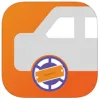Take a look inside 5 images
VelocityLab
Pros: Data about velocity and acceleration streams in real time, allowing kids to build a deeper understanding of motion.
Cons: While example lesson plans are available, the search tool is limited.
Bottom Line: Pair your device with PocketLab sensors to gather position, velocity, and acceleration data on anything that rolls.
VelocityLab is a great way to turn play into science. Use athletic tape to attach the PocketLab sensor onto the spokes of a bike. While one student pedals, the other can see how far and fast the student is riding. Students can test and watch what happens to acceleration when they pedal faster; suddenly words such as "velocity" and "acceleration" mean something.
While VelocityLab works on any wheel or gear, teachers may choose to purchase the HotRod cart along with their PocketLab Voyager sensor. This increases the cost by $20. Alternatively, teachers can download the free instructions to make their own HotRod with a 3D printer. Some teachers have had students build their own cars and enter into a friendly class design competition. VelocityLab can then be used to compare designs.
VelocityLab is an app that allows PocketLab sensors (PocketLab One and PocketLab Voyager) to gather position, velocity, and acceleration data directly from any wheel or gear. Kids can attach them to the wheels of their skateboards, their bicycles, or even a real car. While the wheel is moving, the wireless PocketLab sensor sends data in real time to your iPhone, iPad, Chromebook, or Mac or Android device (using the PocketLab web app).
Students can export the data as a CSV file that can be used with a spreadsheet program such as Excel. Alternatively, they can export a snapshot of the graph from the screen of their phone or tablet. An educator community on the PocketLab site provides examples of lessons. This includes using VelocityLab with other tools such as Evo by Ozobot.
VelocityLab provides new ways of learning about motion. There are many roller coaster physics activities out there that allow kids to design and test simulated coasters, but with VelocityLab, students can actually build a small coaster and attach a PocketLab to the cart. Once it gets rolling, their Chromebook or iOS device (or Mac or Android device with the web app) will let them examine how the acceleration changes as their carts move down the ramps.
Taking learning into the actual physical world does add expense and time to the lesson, but it also helps kids to truly apply the concepts of motion and acceleration and use them to solve problems. Other apps such as Playground Physics can help kids learn about motion in the real world without the $100-150 sensor. But VelocityLab lets kids see a graph of the motion instantly while it's happening.














